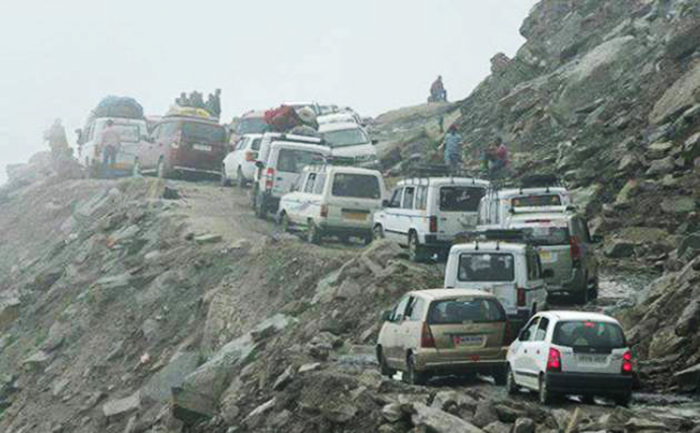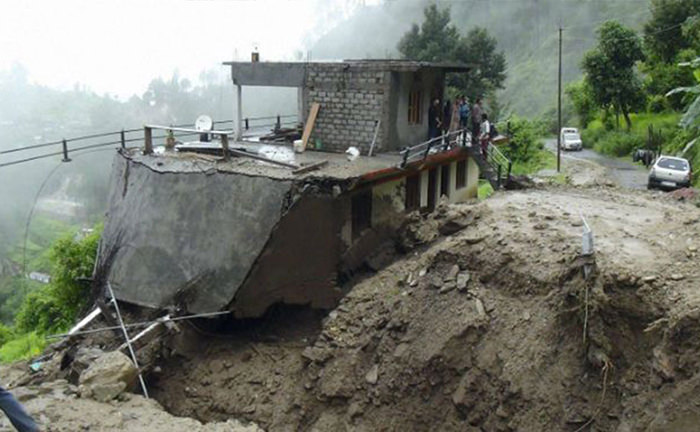Headlines such as 29 dead many missing in the cloudburst, 40 people killed in the landslide at Uttarakhand have become an everyday talk. Our heavenly Uttarakhand is being shattered into pieces as people are busy in skimming the milk from Tourism, Welfare Societies, NGOs and Spirituality. With corruption and greed for money dripping like saliva from the mouth of the government bodies, nobody seems to be interested in finding a solution to the problem as such events are becoming common. The lives lost cannot be brought back to life but with radical measures, one can get to the root cause of it. If we won’t unite for saving our heavenly Uttarakhand then no sooner we will witness doomsday because of our ignorance.
Many people have expressed their condolences and disgust for the natural disasters that have happened in the past but have you ever wondered why is it happening in the Himalayan regions only? Most of the ignorant ones blame it on god but keeping aside things that don’t make any sense, let’s find out the reasons that have triggered the natural disasters in Uttarakhand.
1. Unusual Climate Change in the Himalayas- Studies suggests that the change in the climatic pattern has invited several natural calamities in Uttarakhand.
2. The impact of climate change on Precipitation- It has been recorded that in many areas of Uttarakhand, a greater proportion of total precipitation appears to be falling as rain, than before.
3. Retreating glaciers- It has been observed that Himalayan glaciers are retreating at a rapid rate as compared to the global averages. Also, when the excess melted waters of these glaciers are combined with liquid precipitation it causes flash floods and debris flows.
4. High-intensity rainfall- There has been an increase in the frequency of high-intensity rainfall which has triggered flash floods and landslides in Uttarakhand.
5. An increase in Glacial Lake Outburst Flood (GLOF) events: Events such as high-frequency flash floods and Glacial Lake Outburst are interrelated. In the eastern and the central Himalayas, glacial melts are associated with climate change. This has led to the formation of glacial lakes behind terminal moraines. Many high-altitude glacial lakes are dangerous as they can burst anytime in the Himalayan region. Even the moraine dams are weak and just a fissure can cause gallons of water and debris to discharge, resulting glacial lake outburst floods which can cause extreme flood like conditions. It has also been observed that the GLOF events have increased in the recent decades.

Cloudburst witnessed in Chamoli district of Uttarakhand on Sunday morning caused severe destruction in the region. Source: newsnation.in
1. Illegal Human Activities- The natural disasters are not as natural as the political bureaucrats are trying to portray it. There are countless man-made reasons behind the natural disasters that have happened in Uttarakhand. Some of which are the increased growth in tourism, unplanned construction, an unchecked rapid increase in roads, hotels, shops and multi-storey housing in ecologically fragile areas of the state.
2. Setting up Hydroelectric Dams- The rapid growth of hydroelectric dams have disrupted the water balance as several rivers are being diverted through the tunnels, causing major disasters in the state. More than 220 power and mining projects are running in 14 river valleys of Uttarakhand.
3. Illegal Mining- Activities such as illegal mining in the eco-sensitive zone such as rivers, divert its natural route. Thereby, cutting the natural boundaries of the rivers. This, in turn, disrupts the natural flow of the river bodies, resulting in death and destruction in the nearby areas.
Many proposed hydro-power projects that are currently under construction or commissioned in Uttarakhand (across Indian Himalayas) are storage dams with reservoirs. Even the ‘run of the river’ projects involve reservoirs and big dams. These reservoirs emit methane gas which is 21 times more harmful than carbon dioxide and is also used in boosting the turbines of the dams.
Carbon Credits causing pollution, discounting its impact and inviting havoc in Uttarakhand:
It has come to light that many of the hydropower plants erected in Uttarakhand have applied for carbon credits under the UNFCCC’s Clean Development Mechanism. In this scheme, the clean energy projects in the developing countries get millions of rupees as incentives from the developed world, which in turn get carbon offset credits, a license that is used by the hydro-power plants to pollute further. Such kind of certified clean hydro-power projects in Uttarakhand are a mockery on the clean projects as they are disruptive to the ecosystem. Some of which are 99 MW Singoli Bhatwari HEP, 76 MW Phata Byung HEP, both on Mandakini river (the epicenter of the disaster) and 330 MW Alaknanda Srinagar Hydro-power project.
Effect of climate change on the Forests and Animals:
The current studies and researches conducted in Uttarakhand indicate that the forest structure is changing at a fast pace. From past 20 years, the broad-leaved trees have surprisingly vanished and the pine forests have enveloped the regions which were earlier covered by oaks. The rapidly changing forest structure and human encroachment have caused a threat to the natural habitat of the animals. Many wild animals are left on mercy as they do not get food in the forests which force them to enter into the villages. As a result, the wild animal menace has become a grave problem of today. A preliminary survey reveals that displaced wild animals are causing 30% to 70% damage to the agricultural crops. Thereby forcing them to enter into the farmlands in search of food. While, in many villages the farmers have stopped cultivating vegetables due to the monkey menace. Now, monkeys, boars, and leopards can be easily spotted in the villages of Garhwal Himalayas as their natural habitat is shrinking with time. If this continues the ecosystem will be disturbed and neither man nor any life form will survive on earth.

A road ruptured in the cloud burst occurred in Thipak area of Chamoli district in Uttarakhand.
Source: firstpost
1. Continuously monitoring the weather and eco-system.
2. Effective communication between the meteorological department and people residing in both urban as well as rural areas. For this an early warning system should be introduced to make the people aware whenever any fatal problem arises.
3. Strict guidelines should be made for preserving the natural resources such as water bodies, forests, wildlife and other elements of the eco-system.
4. Those who are found guilty of not abiding the law of conservation of the natural resources should be punished.
5. Proper town planning should be done in the Himalayan areas as many houses rupture due to man-made and natural calamities that occur in the Himalayan regions, resulting in several deaths.
6. Construction in the fragile mountainous areas, natural springs, water resources, watersheds should be barred. Those who are found guilty should be levied with heavy penalties and the illegal structures should be at once demolished.
7. A complete reserve and analysis of the major pilgrim sites based on its location and fragility should be kept.
8. Construction of roads beyond 10 km should be restricted from the protected pilgrim sites as it will create an ecological and spiritual buffer zone around these sites. Also, the development activity of any nature should be strictly prohibited in the buffer zone of the pilgrim places.
9. Hilly roads must provide adequate roadside drains which are connected to the natural drainage system of the area.
10. Proper Disaster Management training should be provided to the locals for mitigating the effects of disasters.
Inputs: sandrp.wordpress.com
Nice
could have included some more info on the 4 impacts (cultural, ecumenic, social and environmental)
very nice